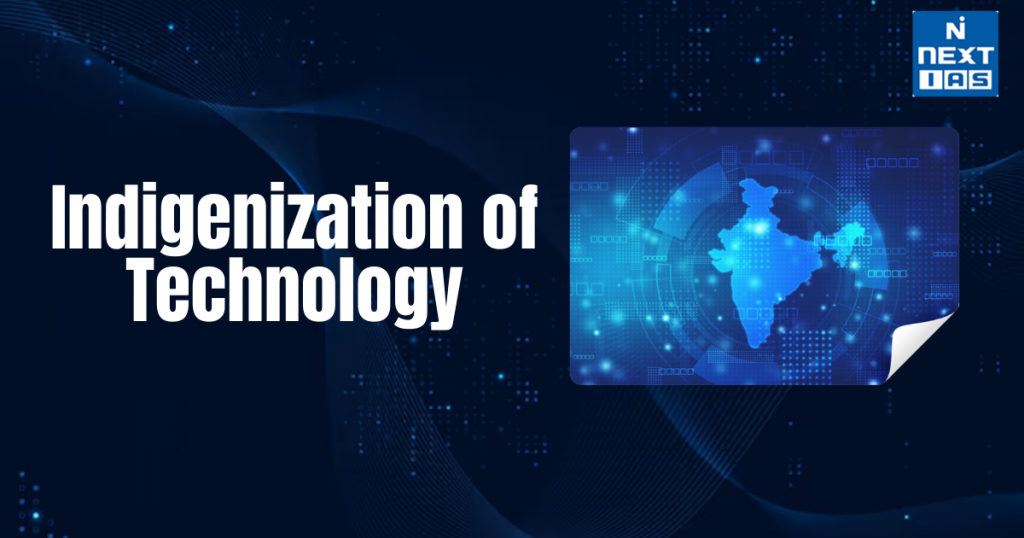
Indigenization of technology involves developing and utilising local resources and skills to design, manufacture, and maintain technological solutions within a country. Its significance lies in enhancing self-reliance, reducing dependence on foreign technology, and fostering innovation that aligns with local needs and cultural heritage. This article aims to study in detail the principles, challenges, and impact of indigenisation in the context of India’s technological landscape.
About Indigenization of Technology
- Technologies employed by a country’s native inhabitants constitute an important part of its cultural heritage.
- The capability to design, develop, and manufacture equipment within the country, using our own skills and resources, constitutes indigenisation.
- The capability to maintain and repair these, as well as equipment sourced from abroad, makes us self-reliant. Not dependence on foreign suppliers for anything makes us self-sufficient.
- The term “indigenisation of technology” goes beyond just manufacturing the item based on drawings and materials supplied by a foreign manufacturer.
- Here, the local manufacturer is expected to understand the technology underlying the product or part to change, modify, improve or re-design the item as and when he likes.
Indigenous Knowledge and Innovations
- Indigenous knowledge is the knowledge of indigenous and local communities that has been developed from experience gained over centuries and adapted to the local culture and environment.
- Indigenous knowledge is the basis for many remote, rural, and marginalised communities in society and is an essential component in the educational development of members within these communities.
- This knowledge is likely disappearing from many communities due to many reasons, such as colonisation, modern society’s lack of understanding, etc.
Importance and Prospects of Indigenisation of Technology
- The desirability of indigenisation can be scrutinised not only from the price perspective but also from the availability of low-cost repair and maintenance over many years of operation of equipment and technologies.
- From the viewpoint of defence and military applications, the value of indigenisation is multiplied manifold in terms of the strategic reliability of ready and direct access to a local manufacturer and his support base.
- Furthermore, an indigenous manufacturer has the added advantage of periodically increasing its product using upgraded technology that could be developed in-house.
- Policies and programmes evolved in various phases can be studied and illustrated with examples.
- The ‘Make in India’ program focuses on increasing India’s manufacturing capacity. It also pushes for much greater domestic private sector participation and is open to attracting ‘FDI in defence’.
- So clearly, military hardware indigenisation has been adopted as a strategic imperative, and the government seems to be proceeding on a twin track of pushing domestic R&D while simultaneously augmenting India’s manufacturing base for defence equipment.
- The Indian Air Force released its indigenisation road map until 2025, highlighting the future technologies and new weapon system capabilities that it plans to induct.
- India has developed the BrahMos missile in collaboration with Russia. It is a medium-range ramjet supersonic cruise missile that can be launched from submarines, ships, aircraft, or land. It is the fastest cruise missile in the world
- India’s first indigenous Aircraft carrier, INS Vikrant, is under sea trials. Like INS Vikramaditya, Vikrant would also employ the Short Take-Off But Arrested Recovery (STOBAR) mechanism with a ski-jump and arrestor cables to launch and recover aircraft.
- With the successful test firing of the indigenously developed nuclear-capable Long-Range Ballistic Missile Agni-5, India moved a step closer to joining the exclusive club of countries with Intercontinental Ballistic Missiles (ICBMs) with a range of over 5,000-5,500 km.
- The success of ISRO’s indigenously developed Mars Orbiter Mission has surprised everyone because it was achieved at a tenth of the cost of similar projects abroad. The fact that India is the only country to have succeeded in its maiden attempt at Mars makes this even more credible.
- The ‘Make in India’ program focuses on increasing India’s manufacturing capacity. It also pushes for much greater domestic private sector participation and is open to attracting ‘FDI in defence’.
National Innovation Foundation
- NIF was established in March 2000, inspired by the Honey Bee Network philosophy, to strengthen grassroots technological innovations and traditional knowledge in India.
- Its mission is to create a creative and knowledge-based society by enhancing the recognition and support for grassroots innovators.
- NIF helps grassroots innovators and traditional knowledge holders receive due recognition and rewards, facilitating the diffusion of their innovations through various channels.
- NIF has compiled a database of over 225,000 technological ideas and practices from more than 585 districts across India, showcasing the breadth of grassroots creativity.
- The foundation has recognised 816 grassroots innovators through its National Biennial Grassroots Innovation Award Functions and the Dr. A.P.J Abdul Kalam Ignite Children Awards.
- NIF has established a Fab Lab in collaboration with MIT for product development and has enhanced laboratory facilities at SRISTI for validating herbal technologies.
- The G2G (grassroots to global) model promoted by NIF aims to transform perceptions of grassroots creativity and innovation on a global scale, demonstrating India’s capability in solving problems sustainably using local resources.
Technology Information, Forecasting and Assessment Council (TIFAC)
- As per the recommendation of the Technology Policy Implementation Committee (TPIC) in 1985, TIFAC was formed as a registered Society in February 1988 under the Department of Science and Technology as an autonomous body.
- It was mandated to assess state-of-the-art technology and set directions for future technological development in important socio-economic sectors in India.
- As a unique knowledge network institution in India, TIFAC activities encompass many technology areas and fill a critical gap in India’s overall S&T system.
- The organization has carried out technology foresight exercises, facilitated and supported technology development, prepared technology-linked business opportunity reports, and implemented mission-mode programmes.
India Technology Vision 2020
- Proposed by former President A.P.J. Kalam in 1998, Technology Vision 2020 aims to transform India from a less-developed to a developed society within 20 years through technological advancement.
- The vision emphasises economic and social development across key sectors, using technology as a pivotal tool.
- A major focus is on food sustainability and security, particularly improving yields in paddy and wheat through a ‘Systems Approach,’ leading to farmers adopting effective practices in Bihar and Uttar Pradesh.
- The vision highlights the importance of literacy and education as foundational to societal development. Initiatives like Mission REACH aim to establish ‘Centres of Relevance and Excellence (CORE)’ through partnerships with industry and institutions.
- Addressing communicable diseases is crucial; improved diagnostics and treatment options are essential for reducing illness prevalence.
- The vision promotes the development of an information society and knowledge economy, emphasising the critical role of ICT and telecommunications as a catalyst for social development.
- Nine educational institutions have been networked under the CORE initiative to enhance manpower quality in societal and industrial relevance areas.
Technology Vision, 2035
- Developed by TIFAC, Technology Vision 2035 outlines a roadmap for addressing India’s challenges and enhancing its technological capabilities by 2035.
- The document aims to ensure security, prosperity, and identity for every Indian and reflects aspirations in multiple languages.
- Twelve key sectors, including education, healthcare, agriculture, water, energy, and ICT, are identified for focused development, and roadmaps are provided for each.
- The vision addresses major challenges such as nutritional security, water quality, holistic education, and decentralised energy solutions.
- The convergence of nanotechnology, biology, IT, and cognitive science raises ethical dilemmas that need careful consideration.
- TV 2035 is rooted in the collective aspirations of the Indian people. It aims to empower democracy and improve the quality of life through technology.
Classification of Technology
Technologies are categorised into six classifications from an Indian perspective:
- Technology Leadership: Niche technologies where India has competencies (e.g., nuclear energy).
- Technology Independence: Strategic technologies are to be developed locally (e.g., in defense).
- Technology Innovation: Integrating and applying breakthroughs across fields (e.g., renewable energy from solar cells).
- Technology Adoption: Modifying imported technologies to local needs (e.g., rainwater harvesting).
- Technology Constraints: Problematic technologies with negative impacts (e.g., GM crops).
Call to Action
The document emphasises the need for:
- Enhanced technical education and research.
- Increased government financial support for R&D.
- Greater participation from the private sector.
- Strong connections between academia, industry, and research.
- Creation of a robust research ecosystem.
Conclusion
In conclusion, the indigenisation of technology in India is not merely about manufacturing but signifies a broader vision of empowerment and sustainability. By harnessing indigenous knowledge and fostering local innovations, India aims to reduce dependence on foreign technologies, enhance self-reliance, and strengthen its defence capabilities. The ongoing initiatives and strategic frameworks, such as Technology Vision 2020 and 2035, reflect the nation’s commitment to addressing pressing challenges while promoting economic growth. As India progresses, the collaboration between grassroots innovators, educational institutions, and government bodies will be vital in realising the potential of a self-sufficient and technologically advanced society. Ultimately, this journey of indigenisation holds the promise of not just technological advancement but also the preservation of cultural heritage and the betterment of lives across the nation.
FAQs
What is the indigenous technology in India?
Indigenous technology in India refers to homegrown innovations and advancements developed using local knowledge, resources, and expertise. Examples include Chandrayaan and Mangalyaan space missions, Tejas fighter jets, DRDO’s missile systems, Ayurveda-based medicines, UPI digital payments, and indigenous vaccines like Covaxin. These technologies enhance self-reliance and national progress.
What are examples of indigenization?
Indigenization involves developing and producing technology locally to reduce dependence on imports. Examples include Tejas fighter jets, BrahMos missiles, INS Vikrant aircraft carrier, DRDO’s radar systems, Covaxin vaccine, UPI digital payments, and ISRO’s satellites. These initiatives strengthen self-reliance, boost innovation, and enhance national security and economic growth.
What are some examples of indigenous technology?
Indigenisation of technology and developing new technology includes Chandrayaan and Mangalyaan space missions, BrahMos missiles, Tejas fighter jets, INS Vikrant aircraft carrier, DRDO’s radar systems, Covaxin vaccine, UPI digital payments, Aadhaar biometric system, and Ayurveda-based medicines. These innovations showcase India’s self-reliance in defense, healthcare, space, and digital infrastructure.






